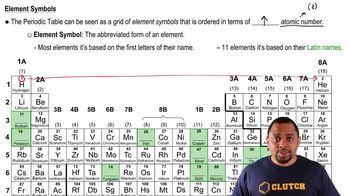Because the oxide ion is basic, metal oxides react readily with acids. (a) Write the net ionic equation for the following reaction: FeO(s) + 2 HClO4(aq) → Fe(ClO4)2(aq) + H2O(l) (b) Based on the equation in part (a), write the net ionic equation for the reaction that occurs between NiO(s) and an aqueous solution of nitric acid.
Ch.4 - Reactions in Aqueous Solution
Chapter 4, Problem 47b
(a) Which region of the periodic table shown here contains elements that are easiest to oxidize? (b) Which region contains the least readily oxidized elements?

 Verified step by step guidance
Verified step by step guidance1
Identify the regions in the periodic table that are color-coded.
Note that the red region (A) represents the elements that are easiest to oxidize.
Observe that the blue region (D) represents the elements that are least readily oxidized.
For part (a), locate the red region (A) on the periodic table, which includes Group 1A (alkali metals) and Group 8A (noble gases).
For part (b), locate the blue region (D) on the periodic table, which includes the transition metals and some post-transition metals.

Verified video answer for a similar problem:
This video solution was recommended by our tutors as helpful for the problem above.
Video duration:
1mWas this helpful?
Key Concepts
Here are the essential concepts you must grasp in order to answer the question correctly.
Oxidation and Reduction
Oxidation refers to the loss of electrons by an atom or ion, while reduction is the gain of electrons. In chemical reactions, these processes occur simultaneously, known as redox reactions. Elements that easily lose electrons are considered good reducing agents and are typically found in specific regions of the periodic table, particularly the alkali metals and alkaline earth metals.
Recommended video:
Guided course

Oxidation and Reduction Reactions
Periodic Trends in Reactivity
The reactivity of elements varies across the periodic table, influenced by their electron configurations. Generally, metals located on the left side and bottom of the table, such as alkali metals, are more reactive and easily oxidized. Conversely, nonmetals on the right side, particularly noble gases, are less reactive and less readily oxidized due to their stable electron configurations.
Recommended video:
Guided course

Periodic Trends
Position of Elements in the Periodic Table
The periodic table is organized by increasing atomic number, with elements grouped by similar properties. The leftmost columns (Groups 1 and 2) contain highly reactive metals that readily oxidize, while the rightmost columns (Groups 15 to 18) include nonmetals and noble gases, which are less likely to oxidize. Understanding this layout is crucial for predicting the behavior of elements in chemical reactions.
Recommended video:
Guided course

Periodic Table History
Related Practice
Textbook Question
Textbook Question
True or false: a. If a substance is oxidized, it is gaining electrons.
Textbook Question
Determine the oxidation number of sulfur in each of the following substances: (a) barium sulfate, BaSO4 (b) sulfurous acid, H2SO3 (c) strontium sulfide, SrS
Textbook Question
Determine the oxidation number of sulfur in each of the following substances: (d) hydrogen sulfide, H2S
Textbook Question
Determine the oxidation number of sulfur in each of the following substances: (e) Locate sulfur in the periodic table in Exercise 4.47; what region is it in?
1
views
